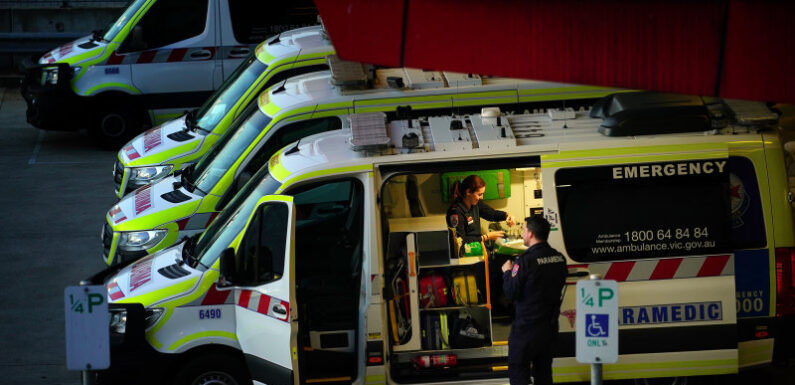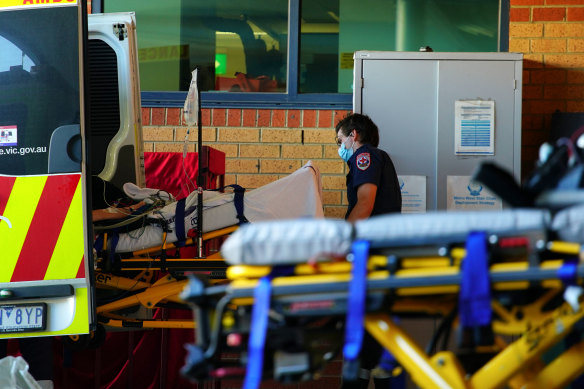
Save articles for later
Add articles to your saved list and come back to them any time.
Demoralising.
That’s how one young paramedic who stood in the cool night outside Box Hill Hospital last week described the all-too-common experience of ambulance ramping. As she filled out paperwork in the brightly lit ambulance bay, her partner waited in the busy hospital with a patient.
A patient arrives at the Northern Hospital in Melbourne, where the ambulance waiting bay is often busy or full.Credit: Luis Enrique
On any given day, a two-person ambulance crew might be stuck at the emergency department for an hour, or two, or four, before they are cleared to return to their truck to pick up a new patient.
For Melbourne’s younger paramedics, this is all they know. There hasn’t been a time when their job hasn’t been synonymous with extended delays transferring patients to congested hospitals.
But they still feel the boredom and frustration that comes with spending so little time on the road that they can only manage a couple of jobs in a 12-hour shift.
“It’s the sitting around, I get more tired doing that, than actually treating unwell patients,” said a junior paramedic as she emerged from Sunshine Hospital on Monday afternoon, where another 20 or so paramedics were still stuck inside.
“You could see there were no beds.”
The young woman gestured to a bag sitting on her stretcher containing two batteries for her patient monitoring equipment. She said the batteries carry enough charge for about four hours.
“Often both batteries will die because you’re waiting so long. And then your monitor won’t work, and you’ll have to find another battery or ask someone else for their battery. That’s how long we are waiting.”
The Age spoke to about a dozen paramedics at ambulance offload areas at three Melbourne hospitals last week.
At Box Hill, an experienced paramedic said he was sick of sending the same two-word text message to his partner waiting for him: “home late”.
“You need a partner who understands you’re not having an affair because you’re late all the time.”
He said he often did overtime because it was not always possible to transfer the care of a ramped patient to another paramedic at the end of a shift.
His colleague, who emerged from the hospital in a mask after dropping off an elderly patient with suspected COVID, said too many patients with minor ailments such as mild chest infections and urinary tract infections were seeking help at hospitals.
“There are far too many patients who don’t need to be here,” he said. “They should be at the primary care centres or referred to their local GPs rather than clogging up the system. [Hospitals] just don’t have the capacity to deal with all the people of low acuity. It is low acuity that is killing them, pardon the pun.”
A low acuity patient is defined by Ambulance Victoria as somebody with “no emergency clinical symptoms or signs of recent onset” or whose condition does “not require active treatment but does require supervised patient transport”.
Several paramedics said while some health services such as the Northern Hospital in Epping were better at letting paramedics offload select patients into their emergency waiting room (known as “fit to sit”), others lagged behind.
Ramping seems to be caused by “a lot of little problems”, observed another paramedic.
“[Hospital] staffing is a problem. Obviously access to beds is a problem. And I think Medicare is a problem as well.”
The man, with more than 10 years’ experience as a paramedic, said patients had told him that they had called for an ambulance because they couldn’t get an appointment with a bulk-billing GP.
“I always tell them. ‘Do you really want to sit in hospital for the next eight hours? Whether you come in with me or you walk in, it’s the same waiting time’.”
Victoria Ambulance Union secretary Danny Hill is concerned about the impact of ramping on graduate paramedics who want and need a variety of on the ground experiences.
“They get real performance anxiety: they just want job after job,” he said. “Unfortunately, the grads aren’t getting that.”
Ambulance ramping is the most disheartening part of being a paramedic, according to Australasian College of Paramedicine chair Ryan Lovett.
“The hardest thing is not the big, gruesome car accident,” he said.
“The hardest thing is sitting in a hospital with a patient who you know needs care but can’t access that care because of the systematic failures.”
He said paramedics were not trained to care for patients for six to 12 hours at a time.
“Their education is focused on urgent and emergency care,” he explained.
“They just want to be out there helping people who are in crisis who are having genuine emergencies in the community.”
New data has exposed the severity of Victoria’s ambulance crisis as hospital ramping costs paramedics 120 years of shifts. Read the full story here.
Most Viewed in National
From our partners
Source: Read Full Article
